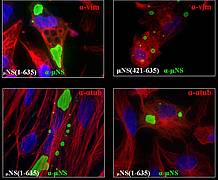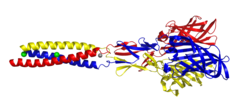European biotechnologists unravel life’s big cellular factories

Fig.1 Reovirus cell attachment protein (fibre) (courtesy of Mark van Raaij, University of Santiago de Compostella), Fig 2. Avian reovirus inclusions formed by protein μNS (Courtesy of Prof. Javier Benavente, University of Santiago de Compostella)

Biotechnologists are poised to take a leap forward in understanding the detailed structure and mechanism of life’s major cellular machines, which could lead to new therapies for a range of diseases and disorders. These machines are large assemblies of macromolecules such as proteins that process external signals to modify gene expression and control biochemical activity inside the cell. Further progress depends on being able to manufacture the machines accurately so that their structure can be studied in the laboratory using techniques such as cryo electron microscopy, x-ray crystallography and high resolution mass spectrometry.
Recent advances in recombinant protein production, and prospects for progress obtaining the structure of important molecular machines involved in critical cellular activities, were discussed at a recent meeting co-organised by the EUROCORES programme EuroSCOPE Science of Protein Production for Functional and Structural Analysis) of the European Science Foundation (ESF). The meeting highlighted progress in harnessing bacteria to produce proteins so that they can then be studied in the laboratory, and used for novel drugs to treat diseases, according to Roman Tuma, a biophysicist from Leeds University in the UK, and a convenor of the EuroSCOPE meeting.
“Currently, the number of protein-based pharmaceuticals is steadily increasing since they are highly specific and exhibit far fewer side effects than traditional drugs,” said Tuma. “However, their wider use is hindered by the higher production costs. The work of Marcus Aebi and colleagues from the Swiss Federal Institute of Technology (ETH) Zurich on engineering E. coil bacterium for production of mammalian proteins will definitely help biotech and pharmaceutical firms to reduce the costs and ultimately bring new treatments to market at affordable cost.” This was a good example of how clever genetic engineering can be used to transform former pathogens into model organisms for research and technology.
Protein complexes play a variety of important roles in assembling cellular components themselves and regulating activities that include expression of genes and subsequent activities of the protein and RNA molecules resulting from such expression. The workshop noted the recent success in determining the structure of the protein factory itself, the ribosome, which is one of biology’s most elaborate and remarkable machines. The workshop also identified another protein complex, the spliceosome, as an important target for investigation. The spliceosome is comprised of protein and RNA units and precisely cuts and re-assembles transcribed RNA into protein-coding messenger RNA, which is subsequently translated by the ribosome into proteins. It does this by removing introns, i.e. non-coding sequences, from the precursor RNA produced by reading the underlying DNA.
Not all protein complexes in the cell play a constructive role. In the event of virus infection, the cell becomes populated by alien macromolecules, which recruit the host’s ribosomes to manufacture proteins the virus needs. At the conference, José Martinez-Costas and Javier Benavente, both from the Santiago University in Spain, described proteins used by the avian reovirus to form viral inclusions, which are areas inside the host cell where the virus houses the components it needs to propagate. These viral "factories" serve to produce new virus that then go on to infect other cells. The assembly of viral factories is an essential step in the virus life cycle and thus constitutes a novel target for drug intervention.
“Avian reovirus is a recurring menace for poultry farms across southern Europe and these epidemics have devastating economic consequences,” said Tuma. “José Martinez-Costas and Javier Benavente made a breakthrough in understanding the essential step of infection during which new reoviruses are formed inside the host cell. This may help with designing a cheap drug intervention which would prevent spread of the epidemic and needless culling of thousands of birds annually.”
The conference included a session on folding, assembly and secretion of complex proteins, aiming to tackle the important bottlenecks that still must be overcome in recombinant protein production. There was also a strong focus on the role of molecular chaperones in protein production in all organisms, since these are essential for correct folding and subsequent assembly after the chain of amino acids has been generated. Molecular chaperones are required to help the correct folding of the chains by preventing incorrect interaction of the polypeptide chain either with itself or with other proteins. Molecular chaperones are also employed during the attachment of carbohydrates and lipids that are needed for the formation of some large molecular complexes.
Apart from folding and assembly, protein complexes are also involved in processing signals transmitted either between or within cells, coordinating the expression of genes and also large scale activities, such as muscle contraction. Signalling between single cell micro-organisms occurs in bacteria that live in colonies or biofilms and is used to coordinate bacterial behaviour, a process that is called quorum sensing. Greater knowledge about the protein complexes that are involved in processing the information will help develop cures for diseases right across the spectrum, including infectious diseases such as Tuberculosis, and certain auto-immune conditions where signalling between human cells goes wrong.
The meeting ended on high hopes of substantial progress, based on growing structural knowledge of the major protein assemblies and their role in the basic processes that occur inside the cell.
The 5th Meeting on Recombinant Protein Production was organised by the Microbial Physiology Section of the European Federation of Biotechnology from 24-28 September 2008 in Sardinia, Italy, near the town of Alghero.
Notes to the editors:
The aim of the European Collaborative Research (EUROCORES) Scheme is to enable researchers in different European countries to develop collaboration and scientific synergy in areas where European scale and scope are required to reach the critical mass necessary for top class science in a global context.
The scheme provides a flexible framework which allows national basic research funding and performing organisations to join forces to support excellent European research in and across all scientific areas.
Until the end of 2008, scientific coordination and networking was funded through the EC FP6 Programme, under contract no. ERAS-CT-2003-980409. As of 2009, the National Funding Organisations provide the funding for the scientific coordination and networking in addition to the research funding.
The European Science Foundation (ESF) provides a platform for its Member Organisations to advance science and explore new directions for research at the European level.
Established in 1974 as an independent non-governmental organisation, the ESF currently serves 80 Member Organisations across 30 countries.
For further information on EuroSCOPE, please click here.
For further information on the EUROCORES Scheme, please click here.
Media contact:
- Dr. Angela Michiko HamaE-Mail
Science contact:
- Mr. Paul BeckersE-Mail

